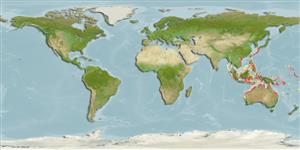>
Lophiiformes (Anglerfishes) >
Histiophrynidae (Starfingered frogfishes)
Etymology: Lophiocharon: Greek, lophos = crest + Greek, charon,-onos = showy, attractive (Ref. 45335); hutchinsi: Named for Barry Hutchins of the Western Australian Museum, Perth..
Environment: milieu / climate zone / depth range / distribution range
Ecologia
marino benthopelagico; distribuzione batimetrica 2 - 9 m (Ref. 59208). Tropical
Distribuzione
Stati | Aree FAO | Ecosystems | Presenze | Point map | Introduzioni | Faunafri
Western Pacific: Australia and Aru Islands in the Arafura Sea.
Size / Peso / Age
Maturity: Lm ? range ? - ? cm
Max length : 4.9 cm SL maschio/sesso non determinato; (Ref. 59208)
Short description
Morfologia | Morfometria
Raggi dorsali molli (totale): 13; Raggi anali molli: 7. This species is distinguished from its congeners in having a reduced esca (scarcely if at all differentiated from the illicium) and a relatively short illicium, covered from base to tip with small dermal spinules (Ref. 59208).
Specimens collected using rotenone or box dredge on sandy mud, sponge, and seagrass (Ref. 59208).
Life cycle and mating behavior
Maturità | Riproduzione | Deposizione | Uova | Fecundity | Larve
Pietsch, T.W., 2004. A new species of the anglerfish genus Lophiocharon Whitley (Lophiiformes: Antennariidae) from Australian waters. Rec. Australian Museum 56(2):159-162. (Ref. 59208)
IUCN Red List Status (Ref. 130435)
Threat to humans
Harmless
Human uses
Informazioni ulteriori
Nomi ComuniSinonimiMetabolismoPredatoriEcotossicologiaRiproduzioneMaturitàDeposizioneSpawning aggregationFecundityUovaEgg development
Age/SizeAccrescimentoLength-weightLength-lengthLength-frequenciesMorfometriaMorfologiaLarveDinamica popolazioni larvaliReclutamentoAbbondanzaBRUVS
BibliografiaAcquacolturaProfilo di acquacolturaVarietàGeneticaElectrophoresesEreditarietàMalattieElaborazioneNutrientsMass conversion
CollaboratoriImmaginiStamps, Coins Misc.SuoniCiguateraVelocitàModalità di nuotoArea branchialeOtolithsCervelliVista
Strumenti
Special reports
Download XML
Fonti Internet
Estimates based on models
Preferred temperature (Ref.
123201): 24.2 - 29.2, mean 28.4 °C (based on 1520 cells).
Phylogenetic diversity index (Ref.
82804): PD
50 = 0.6250 [Uniqueness, from 0.5 = low to 2.0 = high].
Bayesian length-weight: a=0.01995 (0.00906 - 0.04395), b=3.01 (2.83 - 3.19), in cm total length, based on all LWR estimates for this body shape (Ref.
93245).
Trophic level (Ref.
69278): 3.5 ±0.6 se; based on size and trophs of closest relatives
Resilienza (Ref.
120179): Alto, tempo minimo di raddoppiamento della popolazione meno di 15 mesi (Fec assumed to be > 10,000).
Fishing Vulnerability (Ref.
59153): Low vulnerability (10 of 100).
